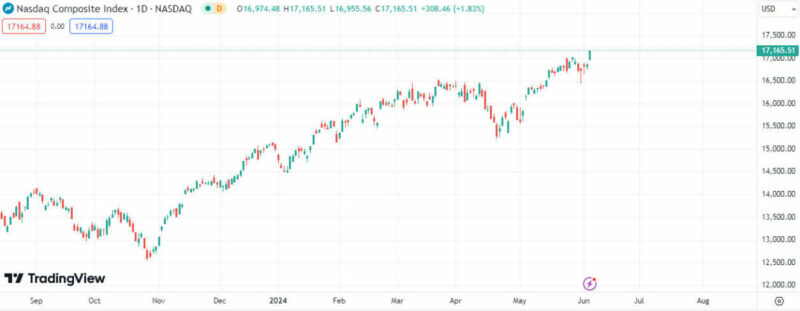The S&P 500 and Nasdaq indexes reached record highs this Wednesday supported mainly by technology stocks as markets digested economic data that could support a much-expected start to the Federal Reserve’s policy easing cycle.

The May private payrolls report released this Wednesday is the latest indication of a loosening labor market, potentially prompting the Fed to consider rate cuts this year. Additionally, a report on Tuesday revealed that job openings in April fell to their lowest level in over three years. Jack Janasiewicz, a portfolio manager at Natixis Investment Managers Solutions in Boston said:
“We’re seeing the economic data starting to ease up a little bit and the repercussions for that is that you’re seeing the pressure on rates come off the boil a little bit mixed in with the potential for weaker economic data, which is a pretty good recipe for the bond market.”
According to the CME’s FedWatch tool, market participants now estimate a nearly 69% probability of a rate cut in September, up from around 50% just last week. However, it is important to say that investors are now looking forward to the nonfarm payrolls report, scheduled for release on Friday, to gain a comprehensive understanding of the labor market and the interest rate path.
See Related: Have Goldman Sachs Analysts Become Overly Optimistic By Revising Their Year-End S&P 500 Index Target Upwards
Monthly Non-Farm Payroll Data
The monthly non-farm payroll data in the U.S. is a critical economic indicator that provides insights into the employment situation but also reflects economic growth, consumer spending potential, and business confidence, making it a closely watched report by investors, policymakers, and economists.
The upcoming monthly non-farm payrolls data is expected to reveal a slowdown in job additions for May and according to economic analysts, many companies could face liquidity problems in the upcoming months. The current high interest rates encourage saving over spending and increase the cost of debt which could be particularly challenging for companies with substantial credit or variable interest rate loans.
Higher borrowing costs can hurt corporate profits and discourage businesses from borrowing to invest in new projects, which can hurt economic activity. This situation could adversely affect stock prices and make fixed-income investments, such as bonds, more appealing than stocks.



